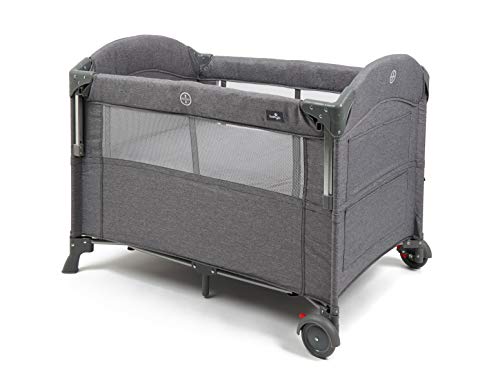10 Misleading Answers To Common Attachable Bedside Crib Questions: Do You Know The Right Answers?

Understanding Co-Sleeper Cribs: A Comprehensive Guide for New Parents
In the ever-evolving landscape of infant sleep solutions, co-sleeper cribs have amassed considerable attention among new parents. These specialized cribs use a special bridge between co-sleeping and safe sleep practices, supplying advantages that resonate with both caretakers and infants. This post looks into the complexities of co-sleeper cribs, outlining their features, benefits, factors to consider, and responding to typical concerns to guide parents in making an informed decision.
What is a Co-Sleeper Crib?
A co-sleeper crib, also called a bedside sleeper, is a type of crib developed to safely connect or sit beside an adult bed. It allows infants to sleep near their parents without the risks typically connected with adult bed-sharing. These cribs can be found in different styles, however most share an essential feature: one side that is lower, making it possible for easy reach to the baby while keeping them in their own designated sleeping space.
Key Features of Co-Sleeper Cribs
- Safe Attachment: Designed to firmly attach to the adult bed, making sure stability.
- Adjustable Height: Height modification options for smooth positioning beside the adult bed mattress.
- Breathable Mesh Sides: Often geared up with breathable mesh sides to improve air flow.
- Compact Design: Takes up less space than conventional cribs, making them ideal for small rooms.
- Portable Options: Many co-sleeper cribs are light-weight or collapsible, enabling easy movement and travel.
Advantages of Using a Co-Sleeper Crib
Co-sleeper cribs present a number of benefits that interest new parents, including:
- Enhanced Bonding: Proximity promotes bonding and can reduce nighttime feedings and reassuring.
- Streamlined Nighttime Feeding: Parents can easily feed or soothe their baby without requiring to rise.
- Decreased Risk of Bed-Sharing Hazards: Co-sleepers create a more secure environment than standard bed-sharing, lowering the threat of suffocation and falls.
- Support of Independent Sleep: Infants have their own sleep space, which promotes independent sleeping routines.
Considerations When Choosing a Co-Sleeper Crib
While co-sleeper cribs offer lots of benefits, there are also several factors to consider that parents ought to evaluate before making a purchase:
- Safety Standards: Always guarantee that the crib abides by current safety guidelines offered by organizations such as the Consumer Product Safety Commission (CPSC).
- Size Compatibility: Measure the adult bed to guarantee the co-sleeper will fit securely and conveniently together with it.
- Alle via te of Use: Look for models that help with easy operation and availability, specifically throughout nighttime.
- Convertible Options: Some co-sleepers use the flexibility to convert into a conventional crib once the child outgrows them, which can be a cost-effective choice.
Leading Co-Sleeper Cribs on the marketplace
To help navigate the abundance of alternatives readily available, here's a table showcasing some popular co-sleeper cribs together with their standout features:
| Brand | Model | Features | Price Range |
|---|---|---|---|
| Arm's Reach | Perfect Arc Crib | Adjustable height, detachable side | ₤ 150 - ₤ 230 |
| Babybay | Initial Co-Sleeper | Made from sustainable wood, includes mattress | ₤ 240 - ₤ 300 |
| Chicco | Next2Me Magic | Easy side access, foldable design | ₤ 200 - ₤ 280 |
| Cuddle Me | Organic Co-Sleeper | Soft, comfortable contours; portable | ₤ 120 - ₤ 180 |
| HALO | BassiNest | 360-degree rotating, height-adjustable | ₤ 250 - ₤ 350 |
Tips for Using a Co-Sleeper Crib
- Positioning: Place the co-sleeper beside the bed at the exact same height level for safety.
- Follow Safe Sleep Practices: Ensure the crib is set up according to guidelines to lessen risks. This includes avoiding loose bedding and keeping the bed mattress company.
- Routinely Check Security: Periodically examine the attachment between the co-sleeper and the adult bed to ensure it remains safe and steady.
Frequently Asked Questions (FAQs)
1. Are co-sleeper cribs safe?Yes, when
used according to the manufacturer's instructions and security guidelines, co-sleeper cribs are considered a safe option to standard bed-sharing.
2. The length of time can my baby use a co-sleeper crib?Most co-sleeper cribs are designed for infants approximately 5-6 months old, however check specific product specifications for age and weight limits. 3. Do co-sleeper cribs include mattresses?Many co-sleeper cribs come with consisted of mattresses, but confirm this before purchase. Guarantee any additional bed mattress fulfills security requirements. 4. Can a co-sleeper crib be utilized for twins?There are co-sleeper cribs developed for twins, but these models may be less typical. Constantly examine the size and weight limits. 5. Must I use a co-sleeper crib for naps?Absolutely! Co-sleepers work well for both nighttime sleeping and naps, supplying a constant sleep environment for infants. Co-sleeper cribs use an effective and safe compromise
for new parents excited to keep their infant close while preserving a secure sleeping environment. By understanding their functions, benefits, and
safety considerations, parents can make informed choices that cater to their family's requirements. Whether you're looking for convenience throughout nighttime feedings or a way to build a strong early bond, a co-sleeper crib may simply be the ideal choice for you and your kid.

